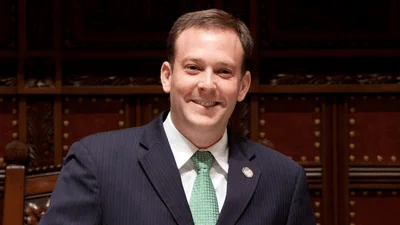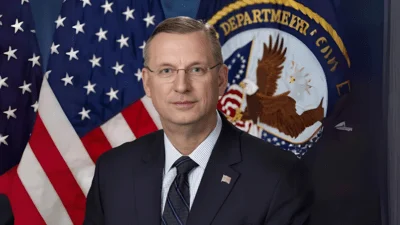Federal Railroad Administration (FRA) | Federal Railroad Administration (FRA)
As local, state, and federal officials continue to investigate the cause of the derailment in East Palestine, Ohio, and monitor public health conditions, U.S. Transportation Secretary Pete Buttigieg called for a three-pronged push to hold the freight rail industry accountable and improve safety. That includes laying out immediate steps for Class I railroads to take to improve rail safety in communities across America and to improve working conditions for rail employees. It comes on the heels of Secretary Buttigieg’s letter to Norfolk Southern’s CEO, in which the Secretary called for an end to the rail industry’s “vigorous resistance” to increased safety measures, which has included litigation and lobbying Congress.
"Profit and expediency must never outweigh the safety of the American people," said U.S. Transportation Secretary Pete Buttigieg. "We at USDOT are doing everything in our power to improve rail safety, and we insist that the rail industry do the same – while inviting Congress to work with us to raise the bar."
The reforms demand that railroads take several actions, including requiring the owners of tank cars to expedite the phase-in of safer (DOT 117) tank cars and to offer paid sick leave for rail workers; call on Congress to increase maximum fines that USDOT can issue to rail companies for violating safety regulations up from the current maximum fine of $225,455; and state that USDOT will advance the train crew size rule and initiate a focused safety inspection program on routes over which trains with large volumes of hazardous material travel.
The full list is below:
We are calling on Norfolk Southern and the entire freight railroad industry to act immediately to:
- Protect workers who spot safety issues from reprisal, by joining FRA’s Confidential Close Call Reporting Program. This program allows railroads and their employees to report unsafe events and conditions without fear of negative consequences from the FRA or reprisal from their employers. To date Amtrak, many commuter rail and short line companies are part of this program, but not a single Class I railroad participates. This must change immediately.
- Deploy new inspection technologies without seeking permission to abandon human inspections. The removal of human inspections has been a top priority for the rail lobbyists. Recent waiver requests around technology like Automated Track Inspection (ATI) have been framed by industry to set up a false choice between technology and human oversight. We need both to keep our nation’s railroads safe.
- Require the owners of tank cars they operate to expedite the phase-in of safer (DOT 117) tank cars in advance of the Congressionally mandated 2029 deadline.
- Provide proactive advance notification to state emergency response teams when they are transporting hazardous gas tank cars through their states instead of expecting first responders to look up this information after an incident occurs. USDOT is also pursuing further requirements in this area, but railroads should not wait.
- Provide paid sick leave. A healthy and well-supported workforce is a safer workforce. This doesn’t have to wait for national negotiations—companies can come to terms individually with their labor unions. Some carriers are in the process of doing this. This Administration believes that all workers deserved paid sick leave.
- Advancing the Train Crew Staffing Rule, which will require a minimum of two crewmembers for most railroad operations. This rule is intended to keep workers and communities safe. Research indicates that an increase in physical tasks and cognitive demands for a one-person crew could potentially lead to task overload or a loss of situational awareness that could cause an accident. Despite two-person train crews being industry standard, the rail industry has resisted being regulated on this front and pushed for crews of less than two people.
- Initiating a focused safety inspection program on routes over which high-hazard flammable trains (HHFTs) and other trains carrying large volumes of hazardous material travel.
- Initiating a focused inspection program of legacy tank cars and the shippers and railroads who have chosen not to upgrade to the safer tank cars (DOT 117).
- Deploying the resources from the Bipartisan Infrastructure Law under programs including the Consolidated Rail Infrastructure and Safety Improvements (CRISI), the new Railroad Crossing Elimination Program and the Railroad Rehabilitation & Improvement Financing (RRIF) program among others to fund projects that modernize and improve rail tracks, eliminate at-grade rail crossings and improve rail safety.
- Pursuing further rulemaking, to the extent possible under current statute, on high-hazard flammable trains (HHFT) and electronically controlled pneumatic brakes (ECP).
- Increasing the maximum fines that USDOT can issue to rail companies for violating safety regulations. The current maximum fine, even for an egregious violation involving hazard materials and resulting in fatalities, is $225,455. This is a rounding error for a company that reported an astonishing record annual operating income in 2022 of $4.8 billion, and has posted operating margins approaching 40%.
- Following through on new bipartisan support to expand and strengthen rules governing high-hazardous shipments, including high-hazard flammable trains (HHFT), pushing past industry opposition.
- Following through on new bipartisan support to modernize braking regulations and increase the use of electronically controlled pneumatic brakes (ECP). 4. Speeding up the phase-in of safer (DOT 117) tank cars to carry hazardous materials. Congress established a phase-in schedule under the 2015 FAST Act which gives owners of tank cars until 2029 to fully adopt stronger (DOT 117) tank cars. The original 2015 HHFT Rule required the phase-in by 2025. Congress can act now to speed, rather than slow, this important safety measure.
- Increasing funding to expand hazardous materials training for first responders.
Investigators from USDOT’s Federal Railroad Administration and the Pipeline and Hazardous Materials Safety Administration were on the ground within hours of the train derailment in East Palestine, Ohio, on February 3, 2023. The agencies are supporting the investigation being led by the National Transportation Safety Board, an independent agency. USDOT will use the results of the NTSB investigation in East Palestine to hold Norfolk Southern accountable, while pushing for rail safety initiatives in the more immediate future.
For more on the federal response, see here.
To get the latest information on the investigation into the derailment in East Palestine, please visit NTSB’s website.
Original source can be found here








